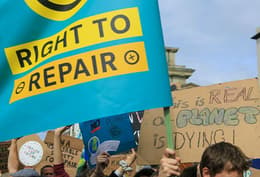
Fast tech’s race to put out the “most innovative device ever” every year is contributing to the climate crisis.
Fast tech is the system of overproduction and overconsumption that relies on devices built to be disposed of — either when they break down or become irrelevant, thanks to the latest “upgrade.”
It’s everywhere you look. In our pockets, in our economy, and especially in our rubbish. It’s time we reckon with the impact of fast tech on our planet.
We're overproducing tech

Smartphones in circulation right now. That’s 2 per person, for the entire global population (yes, including babies).
We’re creating more e-waste

The amount e-waste has increased since 2010. Dumps now spread across the globe, from rural Hong Kong to Mexico.
We’re growing our carbon footprint

The percentage that manufacturing makes up the overall carbon footprint of digital technology.
It’s possible to get the tech we need while mitigating our own environmental impact. Instead of buying what we are told to or letting our old tech pile up forgotten in a drawer or worse, waste away in a landfill, we can get the most out of our devices while participating in giving the planet a break.
The best part? It’s not hard.
You can break the cycle.

Reuse
Make your tech last by using cases and other protective gear.Consider passing along tech to younger family members or those in need.
Repair
Replacing old parts and keeping your devices clean and healthy improves performance.Support the Right to Repair movement and take repair back to the people.
Refurbish
Trade in old tech for cash when you’re ready to move on.Choose refurbished tech with up to 92% less carbon emissions than new.
Meet the computer we're not supposed to sell you (anymore).
Big Tech tried to make these computers obsolete — we can't let that happen. So, we gave them an up-to-date, secure operating system — and are selling them for a ridiculously low price. Available for a limited time only.

Ready to end fast tech?
Educate yourself.
Learn more about fast tech.
Get political
Advocate for your right to repair
Latest news
Share the fight
The total digital industry accounts for 4% of global greenhouse gas emissions and could represent 14% of total global emissions by 2040, all else being equal (projection for 2040 made considering the 2016-level of global greenhouse gas emissions).
In 2022, there were 16 billion phones in circulation worldwide, and 5.3 billion of them became waste.
E-waste volume is growing five times faster than documented e-waste recycling.
On average, 40% of the environmental impact of digital technology’s greenhouse gas emissions is tied to the manufacturing stage.
Up to 92% less carbon emissions than new. ADEME, Assessment of the environmental impact of a setof refurbished products.



